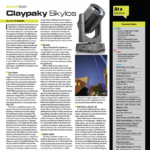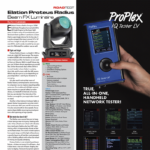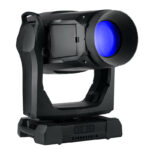You probably read the title of this piece and then the byline, and asked yourself, “Why would a lighting guy be reviewing a video product?” I might start off by noting that it’s really okay for people to venture into unfamiliar terrain and learn something new. I could strengthen that further by saying lighting guys really should learn more about video, since our consoles are being used, more and more, for video cues. So if you’re also a lighting professional looking to learn more about new video technologies, join me as my venture into the world of video production continues.
 What It Is
What It Is
The HyperDeck Studio Pro is Blackmagic Design’s top-of-the-line video recorder. Instead of using any sort of tape media — you remember, those things that look like big cassettes — the HyperDeck line uses solid-state drives (SSD) to store video files. Sounds simple, and it is. The power behind the HyperDeck Studio Pro lies within its circuit boards and microchips. The deck offers a number of recording codecs from Apple’s ProRes HQ to Avid’s DNxHD 220x in MXF or QuickTime wrapper. That means no matter what type of editing software you use, The HyperDeck Studio Pro records in the programs native codec for easy file ingest.
The HyperDeck Studio Pro also offers a number of video formats to choose from. Either SD, HD or 4K format up to 3840x2160p30. Think that is staggering? Wait until you start recording at uncompressed 10-bit. That SSD will begin to fill up in no time flat. A 128 GB SSD will only fit about 13 minutes of uncompressed HD video, while a 512 GB SSD will give you about 50 minutes of record time. Starting to understand why Blackmagic Design gives you two SSD ports?
 Not just any SSD
Not just any SSD
Don’t let the terms, “solid state drive” or “SSD” fool you. SSD technology has been around since 1976, believe it or not. But the SSDs of yesteryear — including the old 2.5-inch SSDs many are familiar with — don’t always offer the fast write rates (500MB per second, minimum) you’ll need for capturing 10-bit uncompressed video. Don’t think for a second that a conventional hard drive’s spinning disk will work, either. With the amount of data that the HyperDeck is trying to write to the disk, your precious video will be choppy or, at a minimum, less then stellar in quality.
Blackmagic Design offers some guidance on which SSDs will work best with the HyperDeck Studio Pro via their website. With any SSD, prepare to spend an extra bit of money depending on how big of a drive you may need. While lesser quality SSD may work, why risk it and having something that doesn’t perform to your needs?
From Front…
The front side of the HyperDeck Studio Pro looks simple, because it is. There are the two 2.5 SSD drive ports off to the right. Surrounding the SSD ports, LED indicators that will light up in either green or red, letting you know which one is currently being recorded to and which drive is ready. There are 12 push buttons for recording, playing back and skipping through the videos recorded onto the drives. Blackmagic Design included a small preview screen for the selected feed coming in, or for viewing the playback. The full color LCD screen also displays sound levels as well and timecode — all very useful features to ensure you get the best quality recording. The jog wheel off to the far right can jog through a recording as well and help move you through the onboard menu system to configure the HyperDeck.
…to Back
The rear panel of the HyperDeck Studio Pro is a video pro’s dream. There are a multitude of connections, from HDMI, SDI, Analog Component, RCA phono jacks for unbalanced audio, timecode and 3pin XLR Audio in and outs. No matter what type of connection you need to make from a source, the HyperDeck Studio Pro can probably handle it. Choosing which connection you want to record from is easy as well; you just toggle the front panel button to make the selection. There is also a USB, Thunderbolt and RS-422 connection in the rear for additional control and for configuring the recorder.
Conclusion
As a lighting guy, I faced a learning curve of sorts when first using the HyperDeck Studio Pro. But if all the different codecs, resolutions and requirements that I encountered in this venture into the foreign world of video kind of threw me for a loop, it also opened my eyes. Like anything else, the more you learn about something, the more you realize you don’t know.
After figuring out my signals and connections, I found that getting down to business with the HyperDeck Studio Pro was very straightforward. It is a no-nonsense digital recorder that packs enormous power in a singe-rack space device.
Sidebar: At a Glance
4K Capture and Playback, 6G-SDI
The HyperDeck Studio Pro is the top-of-the line digital video recorder in Blackmagic Design’s HyperDeck series, with 6G-SDI, HDMI 4K and analog connections along with standard XLR connectors for audio and timecode.
Other Blackmagic HyperDeck models include the HyperDeck Shuttle, a portable model with a single SDD recorder useful for in-the-field projects; and the HyperDeck Studio, with 3G-SDI and standard HDMI connections.
While the HyperDeck Studio records and plays back SD/HD uncompressed, ProRes and DNxHD video, the Studio Pro goes further, supporting Ultra HD 4K capture and playback and offering a built-in Thunderbolt port.
Blackmagic Design HyperDeck Studio Pro
Size: 1RU wide by 7” deep
Codecs: Uncompressed QuickTime, Apple ProRes 422 (HQ) QuickTime, ProRes 422 QuickTime, ProRes 422 (LT) QuickTime, ProRes 422 (Proxy) QuickTime, Avid DNxHD QuickTime, Avid DNxHD MXF
Retail Price: $1,995



